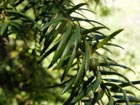Taxus contorta
Griff. 1848, 1854
Common names
West Himalayan yew, Thuner [Hindi], postil [Kashmir], 命叶红豆杉 [miye hongdoushan, Chinese]; luith, luinth, lautho, lauth, or laudo [Nepali], sang ga xing [Tibetan] (Farjon 2010, Poudel et al. 2013).
Taxonomic notes
Synonyms: Taxus fuana Nan Li & R. R. Mill 1997, Taxus wallichiana subsp. contorta (Griff.) Silba 2010. For most of historical time this was known simply as the west Himalayan populations of T. wallichiana, until segregated as T. fuana in 1997. The 1848/1854 description by Griffith (see "Remarks") was only discovered relatively recently, by Spjut while preparing his monograph on Taxus (Spjut 2007).
Type: Afghanistan, Badakhshan, Kafirstan, W. Griffith 5002.
A survey of chloroplast and nuclear DNA markers for seven populations of T. contorta in Pakistan found low haplotype diversity and high inbreeding. Analysis suggests a late Pleistocene demographic range expansion. Climate variability and human exploitation make an uncertain future for this endangered species (Poudel et al. 2014).
Description
Shrubs, or trees to 20 m tall and 300 cm dbh, single or multistemmed; very large specimens usually hollow with regeneration inside the bole; often coppicing from a stump (characters shared with T. baccata). Branches numerous, forming a rounded or pyramidal crown. Bark thin, red-brown, exfoliating in large flakes. Twigs alternate, slender, round, finely grooved along leaf bases, green turning yellow-brown or gray. Leaves spirally inserted but arranged in a V-formation, linear, slightly twisted at the short-petiolate base, 15-40 × 1.5-2.5 mm, with revolute margins and a cuspidate apex. Midrib raised, 0.2 mm wide, continuous to apex on upper surface; flat, 0.2 mm wide, also continuous on lower surface. Leaves dark green with two pale yellow stomatal bands on lower surface; stomata randomly distributed. Pollen cones axial, solitary, in rows along both sides of cone-bearing twigs, ovoid, 6-8 mm diameter, pink when ripe, turning brown. Seed cones axillary, solitary, with a thin green aril that ripens to a succulent red, 9-12 × 7-9 mm. Seeds oblong, slightly flattened, 6-7 × 4-5 mm, green turning dark brown (Farjon 2010).
Distribution and Ecology
SW Tibet (Jilong region); central and W Nepal; India: Himachal Pradesh, Jammu & Kashmir, Uttar Pradesh; N Pakistan; Afghanistan. In Tibet, it occurs at elevations of 2500-3400 m in pine forests or mixed conifer-hardwood forests, usually as a subcanopy tree or shrub (Farjon 2010). In Afghanistan, T. contorta has been recorded as a minor component of conifer forests at elevations of 2400-2900 m in the NE Hindu Kush. In Pakistan, its distribution is also restricted to a relatively narrow altitudinal band (2000-3100 m) in the Northwest Frontier Province, the Federally Administered Tribal Area and the Pakistan territory of Kashmir, where it occurs in mixed conifer forests with species such as Cedrus deodara, Abies pindrow, Picea smithiana and Pinus wallichiana, usually on north facing slopes. In NW India, it occurs in small scattered populations, usually along streams within conifer forests at elevations of 1700-2600 m. In W and central Nepal (west of longitude 83.5° E) T. contorta occurs in similar situations as in India (Thomas 2011).
Distribution data for all species native to east Asia and Malesia, from Conifers of the World, downloaded on 2018.01.26.
Taxus contorta is classified as "Endangered" due to a recent, rangewide population decline of at least 50% but probably less than 80%. The causes of the decline are varied, ranging from over-exploitation associated with medicinal use to overcollection for fuelwood and fodder. The decline is continuing and while the causes are largely understood, in many areas they will not be reversible (Thomas 2011). Taxus wallichiana, as formerly interpreted to include all of T. contorta, is listed on CITES Appendix II, and those protections should thus apply to this species. In Afghanistan, T. contorta has been provisionally assessed as Nationally Endangered by the Afghanistan Wildlife Executive Committee and the eastern conifer forests have been identified as important areas for conservation work, as soon as possible. In Pakistan, T. contorta occupies a number of protected areas, but these are under severe pressure from fuelwood collecting and other activities that are leading to forest degradation. In northwest India it has been assessed as critically endangered at a regional level and harvesting of wild trees has been banned. In Nepal, Taxus wallichiana has been nationally assessed as endangered and the government has imposed harvesting and exporting restrictions (Thomas 2011).
Remarkable Specimens
No data as of 2023.02.23.
Ethnobotany
Traditional uses, which are still extant through most of the species' range, are quite varied. The hard wood is used to make ploughs, digging tools, knife handles, utensils, cups, and containers for various liquids. It is the preferred wood for structural members such as pillars, beams, lintels, and window and door frames; it is particularly sought for use in temples and monasteries. It makes good planks for suspension bridges. The branches provide wood for fuel, and the wood is also burned as incense. A dye is extracted from the bark. The leaves yield a fish poison. The young branches provide sheep and yak fodder. The ripe arils are eaten by people. The wood is used to make the frame of a drum used in religious ceremonies by tribes of Mongol affinity. The trees are planted as ornamentals, and the branches are used for decoration during festivals, and also as thatching for the roofs of animal enclosures. Large, old trees are commonly co-located with temples or monasteries, a yew pole or log may be worshipped or associated with a deity, and yew artifacts are used to chase evil spirits away. Medicinal uses include leaf extracts for cough, cold, fever, headache, and gastrointestinal problems. Bark juice or tea is also used for fever and to feel warm during winter. Leaf or bark juice are taken daily to cure cancer, and a paste made from the bark is applied to the skin to treat headache, muscle pain, joint pain and rheumatism. Of all these uses, the most prevalent are medical use for gastrointestinal complaints, timber, tools, and food (Poudel et al. 2013).
Many of the foregoing traditional uses have a religious or spiritual significance, a pattern also seen in Taxus baccata. Few, if any, other conifers have such diverse religious or spiritual uses. Poudel et al. (2013) observe that "Interestingly, all three species of yews in some study sites were found growing near a temple, monastery or inside sacred areas. Numerous sacred sites occur along the [Hindu Kush-Himalaya] region, where conservation ethics are deeply ingrained in the culture and tradition of indigenous people. They believe that cutting trees from sacred sites may harm their families. Due to religious and spiritual beliefs in the conservation of certain species, or whole sacred sites, endangered plant species like Taxus may greatly benefit from this protection. Despite the overexploitation of yews elsewhere, individual trees at sacred sites are acting as a valuable gene pool for future conservation activities."
In modern globalized culture, the timber is still used for house construction, particularly shingles, and furniture; as well as more specialised uses such as grave coverings and beehives. In Pakistan especially, the timber is also valued as fuel. The bark, leaves and twigs are harvested for the commercial production of Taxol, an anti-cancer drug, and this use is the main driver behind the ongoing decline of T. contorta in India and Nepal (Thomas 2011). Brahmin men and women in India still mark their foreheads with a red dot made from the bark of a yew (Poudel et al. 2013).
Observations
Vladimir Dinets (e-mail, 2004.11.14) reports that large trees can be seen in Pakistan: Ayubia National Park, near Muree, 2-3 hours from Islamabad.
Remarks
The type was collected in 1840 by William Griffith (1810-1845), a British doctor and naturalist, on the second year of his botanical expedition to Afghanistan. The epithet means "contorted" but Griffith does not state why. Note that in his 1848 description, Griffith does not name the species, calling it simply "Taxus ?"; the name is assigned in the published illustration, which appeared in 1854. Both sources were published posthumously following his untimely death in 1845 from a tropical parasitic disease.
Citations
Griffith, W. 1848. Itinerary notes of plants collected in the Khasyah and Bootan Mountains 1837-38, in Affghanistan and neighbouring countries 1839-1841, page 351. Available at the Biodiversity Heritage Library, accessed 2018.01.26.
Griffith, W. 1854. Icones plantarum asiaticarum, Part IV, Plate 376. Available at the Biodiversity Heritage Library, accessed 2018.01.26.
Poudel, Ram C., Michael Möller, De-Zhu Li, Amin Shah, and Lian-Ming Gao. 2013. Yews (Taxus) along the Hindu Kush-Himalayan region: Exploring the ethnopharmacological relevance among communities of Mongol and Caucasian origins. Journal of Ethnopharmacology 147:190-203.
Poudel, Ram C., Michael Möller, De-Zhu Li, Amin Shah, and Lian-Ming Gao. 2014. Genetic diversity, demographical history and conservation aspects of the endangered yew tree Taxus contorta (syn. Taxus fuana) in Pakistan. Tree Genetics & Genomes 10(3):653–665.
Singh, Balkar. 2012. VoF Week: Taxus baccata from Ghangriya near helipad. https://groups.google.com/forum/?hl=en&fromgroups#!topic/indiantreepix/fz8zVpCYjYM, accessed 2018.01.27.
Singh, Gurcharan. 2013a. Gymnosperm Fortnight: Taxodiaceae- Taxus contorta from Kashmir-GS-51. https://groups.google.com/forum/#!topic/indiantreepix/Rq-jQjP4vTo, accessed 2018.01.27.
Singh, Nidhan. 2013b. Gymnosperms Fortnight :: Taxus wallichiana from Ghanghariya-NS 03. https://groups.google.com/forum/#!topic/indiantreepix/rziOo9UiJBY, accessed 2018.01.27.
Thomas, P. 2011. Taxus contorta. The IUCN Red List of Threatened Species 2011: e.T39147A10170545. http://dx.doi.org/10.2305/IUCN.UK.2011-2.RLTS.T39147A10170545.en, accessed 2018.01.27.
See also
Obituary/memoir of William Griffith (Biodiversity Heritage Library, accessed 2018.01.27).





